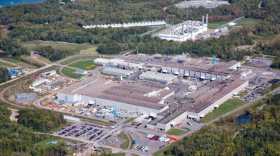It has taken two and a half years for Onondaga County, and the federal and state governments, to develop the plan that examines each impact of the construction of the biggest industrial development project in New York state history.
That means aligning with the National Environmental Policy Act and the State Environmental Quality Review Act.
Onondaga County Executive Ryan McMahon says no other project of this nature has had to endure such an exhaustive review.
"If you look at the main projects, the peer projects that went through the same selection process driven by the repatriating of those jobs to the country, nobody else is going through what we've gone through here," said McMahon. "Which, again, depending on what side of the ledger you are on, is good or bad."
McMahon likes to talk about the Indiana bat when making his point. The tiny bat roosts in trees that Micron wants to cut down in order to build the big semiconductor plant. It’s on the U.S. Endangered Species Act list, which means a project can be halted if it impacts the bat's survival. And McMahon says they seem to be everywhere.
"This bat is doing very well in this community," he said. "I don't know how well the bat does in other communities, but I know in this community, wherever we go for a project, we find it."
As part of the DEIS, Micron promises to create new habitats for the bats, working with the State Land Trust to create twice as much land for it to roost in as it has now.
It has impacted the project in a more substantive way because trees can’t be cut down over the six months of the year when the bats are mating or sleeping, which is why groundbreaking cannot take place before November. McMahon believes it’s time to take a deep dive into the rules that delay or put an end to any sort of development project.
"I think in New York state, when this is all said and done, there's certainly areas where regulatory reform could help make projects move faster. And at the same time, have the protections still that no other state has, right?"
The DEIS is in the midst of a 45-day pubic review process: several local organizations are calling for more time to read the upwards of 20-thousand pages, citing concerns about wetlands, forever chemicals and water usage, to name a few.
There will be three public hearings on July 24 throughout the day at Liverpool High School before the public hearing period ends on August 11. If the DEIS is approved, it would put a late November groundbreaking on the calendar.








